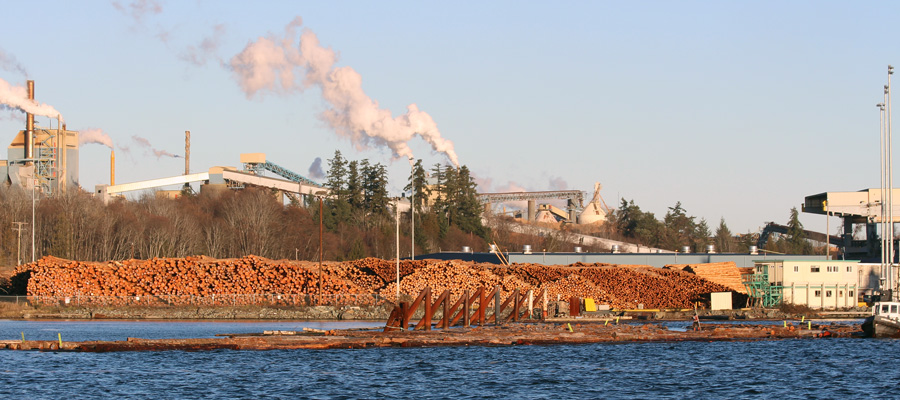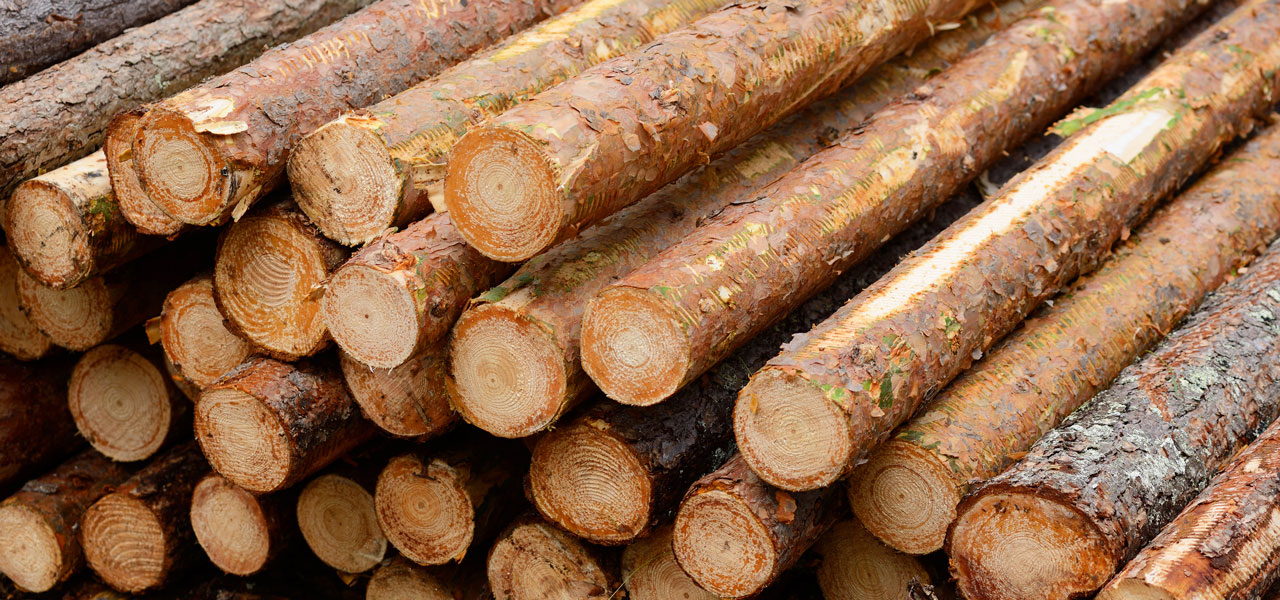How one company’s “value-added” plans are opening the door to more log exports and fewer forest industry jobs

Second of Two Parts
For many years, TimberWest has exported more raw logs from British Columbia than all of its competitors save one. And a new move afoot by the company has both forest industry workers and environmental activists convinced that the company is laying the groundwork for even more exports in the years to come.
Work underway by TimberWest near a pulp mill in Crofton, south of Nanaimo, is setting the stage for the company to load even more raw logs into the holds of ocean freighters, a move that will earn the company higher returns for each raw log.
The move by the company to create what amounts to a new “value-added” raw log export facility comes at a time when TimberWest and Island Timberlands are already BC’s undisputed log export powerhouses.
A database maintained by the provincial government shows the two companies accounted for more than 44 per cent of the nearly 8.1 million cubic metres of raw logs that logging companies hoped to ship from the province in 2016..
The TimberWest picture, in particular, is a cautionary tale of what may lie ahead.
A major reason TimberWest and Island Timberlands exported roughly three to four times more logs than their nearest rivals is that both companies benefitted from purchasing predecessors that at one time owned large swaths of southern Vancouver Island forest land. The companies came to own those lands because of a deal struck in 1871 when British Columbia joined Canada as the young country’s sixth province. At that time, lands were transferred from BC to the federal government to pave the way for railway developments. The lands included a large chunk of forested land on southern Vancouver Island that came to be known as the Esquimalt Nanaimo Land Grant.
As the decades passed, the lands were transferred from railway companies to timber companies. The timber companies coveted them for many reasons, but a few stand out.
- First, the land was extremely good for growing trees, particularly the southern coastal forest’s iconic and valuable softwood species, Douglas fir.
- Second, because the lands were not under provincial Crown control, no timber-cutting (stumpage) fees applied to logging on them.
- Third, as the southern island became more urbanized, land values increased, making them attractive for subdivision and sale for potential housing developments.
Provincial data show that in 2016 Island Timberlands sought to export more than 1.3 million cubic metres of raw logs from private lands and TimberWest sought to export slightly more than 1.6 million cubic metres. Both companies also sought to export significant volumes of logs from Crown lands: TimberWest’s tally from those lands was more than 413,000 cubic metres and Island Timberlands was more than 202,000 cubic metres.
While the two companies may not command much of the export market on Crown lands now, the overall trend in Crown land exports is on the rise with nearly 60 per cent of what companies sought to export in the past five years originating from such lands. Should the province’s two largest raw log exporters increase their Crown land log exports even modestly, that 60 per cent threshold could quickly climb.
The TimberWest picture, in particular, is a cautionary tale of what may lie ahead barring changes in the way the provincial and federal governments regulate the booming log export industry.
BC pulp companies are increasingly forced to buy more whole logs to turn into chips in order to stay in business.
The company’s latest venture at Crofton has flown largely under the radar. The plan is ingenious in its simplicity and does create a “value-added” product of a sort. A large area of land near an existing docking facility has been paved so that more raw logs can be delivered by truck. Each log will then be run through a “debarker”, which strips the outer layer of bark. Each log stripped of its bark becomes smaller in diameter, meaning many more logs can be loaded into the holds of arriving ocean freighters. The smaller logs mean lower shipping costs per unit and higher profits. Hence the “value added”, but clearly this is not what most advocates for sustainable forestry envision by that term.
The pulp mill at Crofton owned by Catalyst will also benefit from the operation as the bark can be used as an energy source in the mill. But that is a far cry from what workers at Crofton and other pulp mills on BC’s coast really need—wood to make pulp and paper. Historically, the cheapest and best source of that wood was the left-over chips and sawdust produced when local sawmills processed logs.
Whenever round logs are processed into rectangular lumber pieces at sawmills a great deal of “waste” is generated in the form of chips and sawdust. That waste historically provided pulp and paper companies with the bulk of their needs. But with so many of the province’s sawmills closing their doors in the past two decades, pulp mill operators have had to scramble to find the wood they need. In what amounts to “value subtracted”, BC pulp companies are increasingly forced to buy more whole logs to turn into chips in order to stay in business.
At Nanaimo’s Harmac pulp mill, not far from Crofton, the shortage of wood chips and sawdust from BC’s remaining coastal sawmilling industry is so acute the company is forced to buy and chip 600,000 cubic metres of logs annually. That amount of logs is more than enough wood to supply two new coastal sawmills, which could employ hundreds more forest industry workers. Those operations would, in turn, generate wood “waste” that could support yet more workers in the pulp and paper industry.
TimberWest, like other companies operating on BC’s coast, is under no obligation to operate mills, meaning there are virtually no hurdles in exporting raw logs.
For decades, that was how business was done in BC’s forest industry. In fact, it was pretty much a requirement. Companies that logged some of the same lands that TimberWest and Island Timberlands log today were granted long-term rights of access to forest land by the provincial government on the explicit understanding they would run sawmills near their logging operations.
In 2003, the provincial government scrapped that requirement, which encouraged a sharp increase in raw log exports. TimberWest’s role in the events prior to and around the time of those rules changes is worth noting, particularly in light of the efforts now underway at Crofton.
Crofton’s pulp mill was once owned by BC Forest Products (BCFP), then the second-largest forest company in the province next to MacMillan Bloedel (MacBlo). Both BCFP and MacBlo ran highly integrated forestry operations. The logs they cut were processed in their sawmills, the wood waste generated at their sawmills became the feedstock for their pulp mills. Both corporations were taken over by larger multinationals, and in both cases the new owners decided to break up the assets they had purchased. The new buyers focused on “core” areas of business. When New Zealand-based Fletcher Challenge was done dismantling BCFP, TimberWest emerged from the ashes to become essentially a “pure” logging company with a substantial side interest in real estate.
In January 2001, TimberWest closed the one manufacturing facility it had, the Youbou sawmill in the small Vancouver Island community of Lake Cowichan. With the closure, 220 men and women lost their jobs. At the time, 100,000 people worked in the province’s forest industry, about 40,000 more than today. Notably, the Crofton pulp mill was among the remaining mills on the coast affected by the closure. The Youbou sawmill had been one of Crofton’s major wood chip suppliers.
TimberWest, like other forest companies operating on BC’s coast, is now under no obligation to operate any mills, meaning there are virtually no hurdles in its path to exporting raw logs.
Under current rules, only logs deemed “surplus” to the needs of domestic sawmills can be exported with a “fee in lieu” of manufacturing paid to the province for exported logs that originated from logging operations on provincial lands.
The enormous volume of logs shipped from BC by TimberWest indicates that the company is exporting logs both from lands it owns outright and from Crown lands, including logs from the company’s Tree Farm Licence (TFL) 47. TFL 47 was once one of those licences that required the holder to operate mills. But that rule no longer applies.
For more than a decade the government has allowed more and more trees from lands under its control to leave the province without ever being run through a mill.
TFL 47 also has the distinction of including lands at the southern end of the Great Bear Rainforest, where for a number of years TimberWest has been in conflict with Sonora Island residents and others who have fought the company’s ongoing and proposed logging of centuries-old Douglas fir and Western red cedar trees in the region.
One aspect of the dispute, as first reported by The Tyee’s Andrew Nikiforuk, is whether or not TimberWest’s definition of “second-growth” forests includes forests that may actually contain increasingly rare and exceedingly valuable old-growth trees.
In an effort to quantify where raw logs exported from the province originate, the Canadian Centre for Policy Alternatives filed a Freedom of Information request with the provincial Ministry of Forests Lands and Natural Resource Operations. The request was for a list of all “timber marks” associated with logs linked to export shipments. The Ministry declined to release the information. The Canadian Centre for Policy Alternatives is challenging the decision and has filed a request for review with the provincial Office of the Information & Privacy Commissioner.
Regardless of whether the provincial government eventually releases the timber mark data, a disturbing reality remains: For more than a decade the government has allowed more and more trees from lands under its control to leave the province without ever being run through a mill and turned into any one of a number of forest products that British Columbians regularly use. The manufacturing of those products historically provided thousands of British Columbians with good-paying jobs that have been the economic backbone of many of the province’s rural communities.
Under existing rules, there is nothing stopping companies that own and operate mills in the province from doing exactly what TimberWest has done, which is to close mills and put hundreds and conceivably thousands more people out of work.
Barring a change in approach, today’s log exports may very quickly be overshadowed by those of tomorrow.
Part One: The Great Log Export Drain
Topics: Economy, Employment & labour, Environment, resources & sustainability


